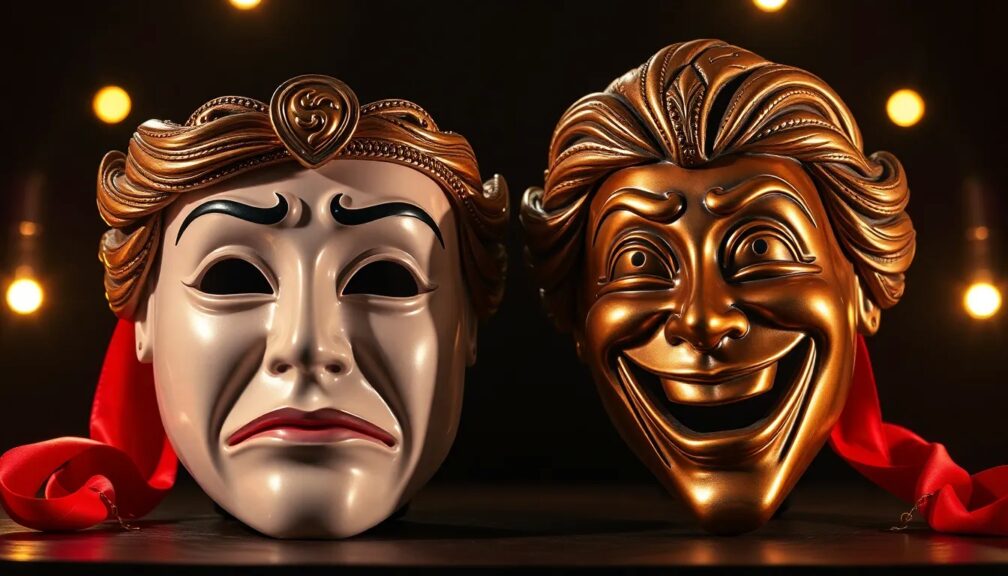The History and Meaning of Theater Masks

Did you know that the origins of theatre masks can be traced back to ancient Greece, where they were used in performances that combined music, dance, and storytelling? These early masks not only enhanced the visual appeal of the performers but also allowed actors to portray a range of characters and emotions in a time when the art of acting was still evolving. The evolution of theatre masks is a rich tapestry woven from cultural practices, artistic expression, and human emotion, reflecting the diverse societies that have used them throughout history.
From their beginnings in ancient rituals to their integral role in modern theatrical performances, the story of masks in theatre is a captivating exploration of human creativity and cultural significance. This article delves into the history of theater masks, their meaning across cultures, and the profound impact they have had on the performing arts. We will explore various types of masks, their symbolic meanings, and how they have transformed the landscape of performance art over thousands of years.
The Origins of Masks in Theatre
The concept of wearing masks dates back to prehistoric times, where they were likely used in rituals and ceremonies. As societies evolved, so too did the purpose and design of theatre masks. In ancient Greece, masks were crafted from materials such as linen, leather, and wood, and were painted in vibrant colors to enhance their visibility to audiences seated far from the stage. These masks were not merely decorative; they served practical functions in performance. The exaggerated facial features allowed actors to convey emotions and character traits more effectively, even from a distance.
Greek theatre itself began as a form of worship to the god Dionysus, where masks played a crucial role in the rituals performed in his honor. These masks often represented the duality of tragedy and comedy, a theme that remains prevalent in modern theatre. The two masks of drama, symbolizing the comedic and tragic aspects of storytelling, became emblematic of the performing arts and continue to be recognized today. This duality speaks to the human experience, encompassing joy and sorrow, laughter and tears, and the myriad emotions that define our lives.
As theatre spread throughout Europe during the medieval period, the use of masks evolved. They became prominent in commedia dell'arte, a form of improvised theatre that originated in Italy in the 16th century. Actors wore masks that represented various stock characters, each with distinctive personalities and traits. This style of performance emphasized physical comedy and improvisation, showcasing the versatility of acting with masks. The masks of commedia dell'arte laid the groundwork for future theatrical traditions and influenced the development of character archetypes in storytelling.
Cultural Significance of Masks
Masks have held profound cultural significance across various societies, serving as symbols of identity, spirituality, and social commentary. In many indigenous cultures, masks are used in rituals and ceremonies to connect with the spiritual realm or to embody ancestral spirits. For instance, African tribal masks are often intricately designed and used in dances that convey stories, myths, and historical events. These masks are not just artistic expressions; they carry deep meanings and are integral to the community's cultural identity.
In the context of musical theatre, masks continue to play an important role in storytelling. They allow performers to step outside their own identities and inhabit the characters they portray. The use of musical theatre masks can amplify the emotional resonance of a performance, enabling actors to convey complex feelings and themes. Whether it’s the joyous celebration of life or the somber reflection on loss, masks provide a powerful tool for expression.
Furthermore, the symbolism of masks extends beyond the stage. In many cultures, the act of masking represents transformation, allowing individuals to explore different facets of themselves or to connect with the divine. This transformative quality is a key reason why masks have persisted in various art forms throughout history. The ability to hide one’s identity while simultaneously revealing deeper truths is a powerful aspect of what masks represent in both theatre and life.
Types of Masks in Theatre
The variety of types of masks in theatre is vast, each with its unique design, purpose, and cultural background. Traditional theatre masks can be broadly categorized into several types, including full-face masks, half masks, and character masks. Full-face masks cover the entire face and are often used in performances where anonymity or transformation is desired. These masks are common in cultural rituals and classical theatre, as they allow the performer to fully embody their character without the constraints of their own identity.
Half masks, which cover only the upper part of the face, are popular in commedia dell'arte and other forms of physical theatre. These masks allow for greater facial expression, making them suitable for comedic roles where exaggerated emotions are essential. The use of half masks can enhance the physicality of a performance, as actors can still utilize their lower face for expressions while maintaining the character’s anonymity.
Character masks are another significant category, often associated with specific roles or archetypes. These masks are carefully crafted to reflect the personality, status, and emotional state of the character. In ancient Greek theatre, for example, the masks used for tragic characters were typically larger and more expressive than those used for comic roles. This differentiation helped audiences understand the nature of each character and their emotional journey throughout the performance.
The Role of Masks in Performance Arts
The role of masks in performance arts transcends mere aesthetics; they are integral to the very fabric of storytelling. Masks allow actors to convey complex emotions and narratives without relying solely on spoken dialogue. This is particularly evident in masked theatre, where the visual impact of the mask can evoke strong reactions from the audience. The physicality of the performers, combined with their masked identities, creates a unique theatrical experience that invites viewers to engage with the story on a deeper level.
In contemporary theatre, the use of masks has been explored in various innovative ways. Playwrights and directors have embraced the potential of mask performances to challenge traditional storytelling methods. For instance, productions such as "The Lion King" and "War Horse" utilize masks and puppetry to create fantastical worlds that captivate audiences. These performances demonstrate that masks can serve not only as tools for character representation but also as vehicles for imagination and creativity.
Moreover, the practice of masking in theater has been embraced in educational settings, where acting with masks is used as a valuable tool for developing performance skills. Workshops and classes often incorporate mask work to help actors explore their physicality, expressiveness, and emotional range. By removing the emphasis on facial expressions, actors can focus on their body language and voice, leading to a more authentic and impactful performance.
The Evolution of Masks in Modern Theatre
As theatre has evolved over the centuries, so too has the design and application of masks. In modern theatre, masks are often crafted from a variety of materials, including foam latex, silicone, and even digital technology. This evolution allows for greater versatility and creativity in mask design, enabling artists to push the boundaries of traditional theatre. Contemporary mask makers often draw inspiration from various cultural traditions, resulting in a fusion of styles that enrich the theatrical landscape.
The rise of physical theatre and avant-garde performances has also contributed to the resurgence of masks in modern storytelling. Productions that embrace minimalism or abstraction frequently utilize masks to convey themes and emotions without relying on realism. This approach invites audiences to engage with the performance on a conceptual level, allowing them to interpret the narrative in their own unique ways.
In addition, the impact of technology on theatre has led to new possibilities for theatrical masks. With the integration of digital projections and video mapping, masks can be enhanced with visual effects that transform the audience's experience. This innovative approach allows for a dynamic interplay between the performer and the mask, creating a captivating synergy that captivates contemporary audiences.
The Significance of the Happy and Sad Masks
The iconic happy and sad masks, often associated with the performing arts, are symbolic representations of the duality of human emotion. These two masks encapsulate the essence of theatre itself—an exploration of the human experience that encompasses a wide spectrum of feelings. The happy mask represents joy, laughter, and celebration, while the sad mask embodies sorrow, tragedy, and contemplation. Together, they serve as a reminder of the complexities of life and the myriad emotions we encounter.
The significance of these masks extends beyond the stage, as they resonate with audiences on a personal level. They invite viewers to reflect on their own experiences and emotions, creating a connection between the performance and their own lives. This emotional resonance is what makes theatre such a powerful medium for storytelling, allowing audiences to find solace, joy, and understanding through the shared experience of the performance.
In educational contexts, the happy and sad masks are often used to teach students about emotional expression and characterization. By exploring the meanings behind these masks, actors can gain insight into the emotional landscape of their characters and deepen their understanding of the narratives they portray. This exploration of emotion through the lens of drama masks fosters empathy and self-awareness, essential qualities for any performer.
In modern contexts, the happy and sad masks have also found their place in popular culture, appearing in various forms of media, merchandise, and art. Their enduring appeal speaks to the universal themes of human emotion and the desire to connect with others through shared experiences. This timeless symbol continues to inspire artists and audiences alike, reminding us of the power of storytelling in all its forms.
The Future of Masks in Theatre
As we look toward the future, the role of masks in theatre is set to evolve even further. The intersection of technology and storytelling presents new opportunities for innovation in mask design and performance techniques. The rise of virtual reality and augmented reality experiences has the potential to transform how masks are used in storytelling, allowing for immersive experiences that engage audiences in unprecedented ways.
Moreover, the growing interest in cultural diversity and representation in theatre is likely to influence the types of masks created and the stories told. Artists are increasingly drawing inspiration from a wide range of cultural traditions, incorporating elements from various societies into their work. This fusion of styles not only enriches the theatrical experience but also fosters a deeper sense of connection and understanding among diverse audiences.
As the performing arts continue to adapt and change, the significance of masks will remain steadfast. They will continue to serve as powerful symbols of identity, transformation, and emotional expression, reflecting the complexities of the human experience. The history of theatrical masks is a testament to the resilience of artistic expression and the enduring power of storytelling, ensuring that masks will remain an integral part of the theatre for generations to come.
In celebrating the rich history and cultural significance of masks, we honor the artistry and creativity that have shaped the performing arts. From ancient rituals to modern performances, masks have woven their way through the fabric of human expression, inviting us to explore the depths of our emotions and the stories that connect us all.



